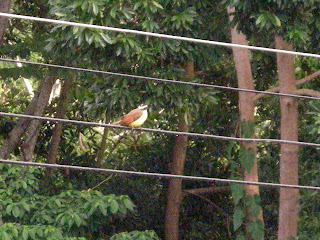This is the most common bird in our garden. The Great Kiskadee (Pitangus sulphuratus derbianus) is very similar to the Boat-billed Flycatcher and the Social Flycatcher but is easily distinguished by the rufous wings and tails. The reddish brown color unfortunately only shows up in the top picture.
 They look like little bandits to me with the black stripe across their eyes and the little black cap. The last photo is a juvenile and doesn't yet have the black cap.
They look like little bandits to me with the black stripe across their eyes and the little black cap. The last photo is a juvenile and doesn't yet have the black cap. The Great Kiskadee gets its name from the varying sounds that it makes which sound like 'kis-k-dee.'
My book, A guide to birds of Mexico and Northern Central America describes the voice as:
Calls loud, raucous, and screaming, including a loud k-reah! or kih-kerrr, and ki ke-reeh or kis-k-dee, etc. Dawn song (?) a raucous kyah k-yah zzk-zzik kyar, and longer variations, repeated.
 They aren't exaggerating about the raucous and repeated! They also make a noise which sounds exactly like it is saying "Christopher!" These birds go nuts screeching loud calls at daybreak and at first we thought we would never be able to sleep in. I guess it is kind of like people who live near train tracks − now we don't even notice it most mornings.
They aren't exaggerating about the raucous and repeated! They also make a noise which sounds exactly like it is saying "Christopher!" These birds go nuts screeching loud calls at daybreak and at first we thought we would never be able to sleep in. I guess it is kind of like people who live near train tracks − now we don't even notice it most mornings. The personality of this bird reminds me of the blue jays that I used to have in my garden in Texas. They don't like other intruders in their territory and often chase the other birds away.
The personality of this bird reminds me of the blue jays that I used to have in my garden in Texas. They don't like other intruders in their territory and often chase the other birds away.In fact, when we first moved in, they used to throw themselves against the windows repeatedly as if they were trying to chase us away, too. I don't mean that they accidentally flew into the windows as many birds have done. They would stand on the windows sills and attack the window over and over again! It sounded as if someone was trying to break into the house.
Every afternoon, around 3 or 4 p.m., two or three of them congregate on the railing on the upstairs terraza (terrace). That is where most of these pictures were taken. It is hard to get a photo as, generally, the slightest movement from inside the house will scare them away, but these were taken when I was sick in bed in December and I just happened to have the camera on the nightstand.
They nest on our roof and in our rain gutters (not a good thing!), making a covered nest of grass and weeds. These birds can be found in the lower altitudes throughout Mexico, Central America, and the southernmost tip of Texas.



 Welcome to my Blogicito —
Welcome to my Blogicito — 







